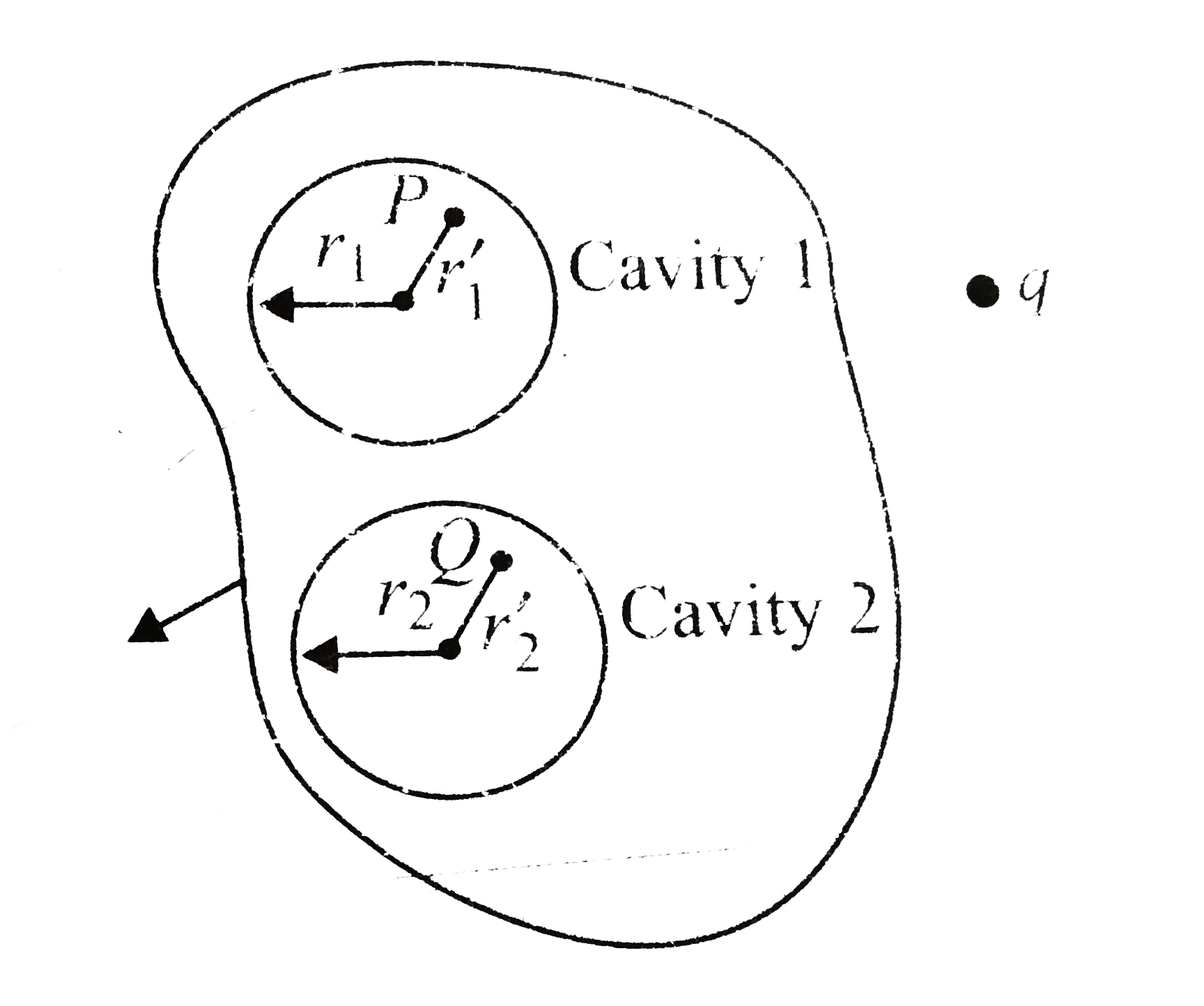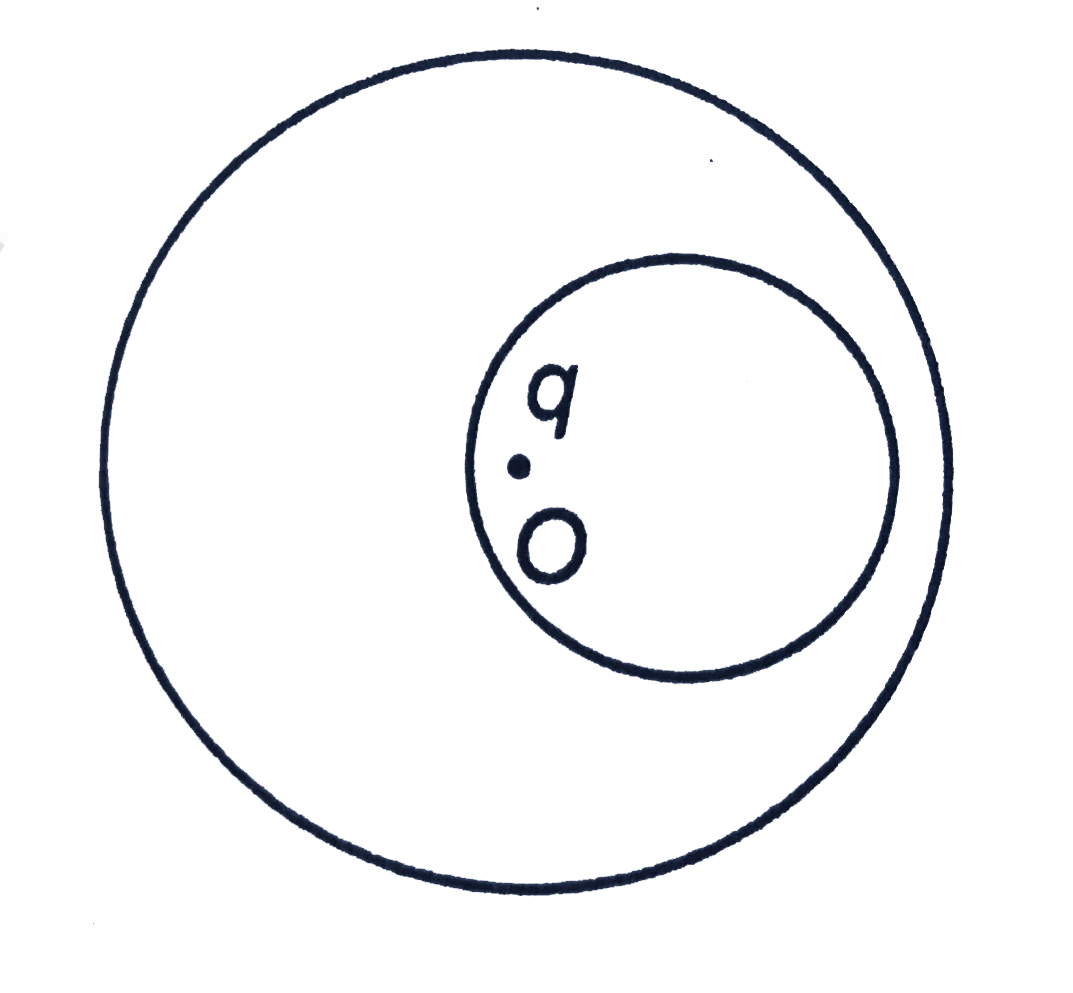A point charge q1 is placed inside cavity 1 and another point charge q2 is inside cavity 2. A point charge q is placed outside the conductor. For the situation described above, answer the following questions.
→E inside the conductor at point S distant r from point charge q, due to charge on outer surface of the conductor, would be
(Q+q1+q2)/4πε0r2 away from charge q
q/4πεr2 towards charge q.
zero
cannot be determined
The correct Answer is:B
To solve the problem, we need to analyze the electric field inside the conductor due to the charges placed both inside the cavities and outside the conductor. Here’s a step-by-step breakdown of the solution:
Step 1: Understand the Setup
We have a conductor with two cavities. Inside cavity 1, there is a point charge q1, and inside cavity 2, there is another point charge q2. Additionally, there is a point charge q placed outside the conductor.
Step 2: Apply Gauss's Law
According to Gauss's Law, the electric field inside a conductor in electrostatic equilibrium is zero. This means that any electric field produced by charges inside the conductor or outside the conductor does not penetrate into the conductor itself.
Step 3: Electric Field Inside the Conductor
Since the electric field inside the conductor must be zero, we can conclude that the electric field at point S, which is located inside the conductor at a distance r from the external charge q, is also zero.
Step 4: Conclusion
Thus, the electric field →E inside the conductor at point S due to the charge on the outer surface of the conductor is:
→E=0
We have a conductor with two cavities. Inside cavity 1, there is a point charge q1, and inside cavity 2, there is another point charge q2. Additionally, there is a point charge q placed outside the conductor.
According to Gauss's Law, the electric field inside a conductor in electrostatic equilibrium is zero. This means that any electric field produced by charges inside the conductor or outside the conductor does not penetrate into the conductor itself.
Since the electric field inside the conductor must be zero, we can conclude that the electric field at point S, which is located inside the conductor at a distance r from the external charge q, is also zero.
Thus, the electric field →E inside the conductor at point S due to the charge on the outer surface of the conductor is:
→E=0
Topper's Solved these Questions
- MISCELLANEOUS VOLUME 3BOOK - CENGAGE PHYSICS ENGLISHCHAPTER - MISCELLANEOUS VOLUME 3EXERCISE - Interger Answer type
20 Videos
- MISCELLANEOUS VOLUME 3BOOK - CENGAGE PHYSICS ENGLISHCHAPTER - MISCELLANEOUS VOLUME 3EXERCISE - Fill in the blanks
10 Videos
- MISCELLANEOUS VOLUME 3BOOK - CENGAGE PHYSICS ENGLISHCHAPTER - MISCELLANEOUS VOLUME 3EXERCISE - Assertion and Reason Type
8 Videos
- MAGNETIC FIELD AND MAGNETIC FORCESBOOK - CENGAGE PHYSICS ENGLISHCHAPTER - MAGNETIC FIELD AND MAGNETIC FORCESEXERCISE - Multiple Correct Answer type
2 Videos
- MISCELLANEOUS VOLUME 5BOOK - CENGAGE PHYSICS ENGLISHCHAPTER - MISCELLANEOUS VOLUME 5EXERCISE - Integer
12 Videos
Similar Questions
A point charge q1 is placed inside cavity 1 and another point charge q2 is inside cavity 2. A point charge q is placed outside the conductor. For the situation described above, answer the following questions.

The charge on outer surface of the conductor would be
View SolutionA point charge q1 is placed inside cavity 1 and another point charge q2 is inside cavity 2. A point charge q is placed outside the conductor. For the situation described above, answer the following questions.
If charge q2 is at point Q (inside cavity 2), then →E at the center of cavity 2 due to induced charge on the surface of cavity 2 would be
View SolutionA point charge q1 is placed inside cavity 1 and another point charge q2 is inside cavity 2. A point charge q is placed outside the conductor. For the situation described above, answer the following questions.
If the potential of the conductor is V0 and charge q2 is placed at the center of cavity 2, then potential at point Q is
View SolutionA positive point charge q1 is placed at (a,0) and another positive point charge q2 is placed at (0,a) . Find the force acting on q1.
View SolutionA point charge q is placed in a cavity in a metal block. If a charge Q is brought outside the metal, will the charge q feel an electric force?
View SolutionA point charge +q is placed at origin O. The work done in taking another point charge -q from the point A to point B along the circular arc as shown in the figure is
_PHY_E05_122_Q01.png) .
.
View SolutionA point charge q is placed at the origin . How does the electric field due to the charge very with distance r from the origin ?
View SolutionA charge q is placed at O in the cavity in a sphereical uncharged conductor. Points S is outside the conductor. If q is displaced from O towards S (still remaining within the cavity)

View SolutionIn front of an earthed conductor a point charge +q is placed a shown in figure

View SolutionA thin metallic spherical shell contains a charge Q on it. A point charge q is placed at the center of the shell and another charge q1 is placed outside it as shown in the figure. All the three charges are positive. Find the force on the charge

a. at centre due to all charges.
b. at center due to shell.
View Solution
